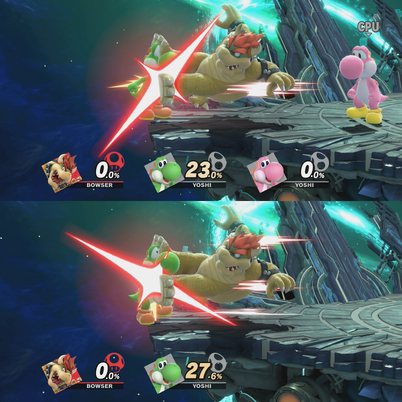| Welcome to SmashWiki! Log in or create an account and join the community, and don't forget to read this first! |
| Notices |
|---|
| The Skill parameter has been removed from Smasher infoboxes, and in its place are the new "Best historical ranking" and "Best tournament result" parameters. SmashWiki needs help adding these new parameters to Smasher infoboxes, refer to the guidelines here for what should be included in these new parameters. |
| When adding results to Smasher pages, include each tournament's entrant number in addition to the player's placement, and use the {{Trn}} template with the matching game specified. Please also fix old results on Smasher pages that do not abide to this standard. Refer to our Smasher article guidelines to see how results tables should be formatted. |
| Check out our project page for ongoing projects that SmashWiki needs help with. |
1v1 multiplier

The 1v1 multiplier, officially known as 1-on-1 damage, is a mechanic in Super Smash Bros. Ultimate. First revealed by Masahiro Sakurai at E3 2018, its purpose is to speed up matches between two players. When a match is started with only two players, and items are off, characters take 1.2× damage from all sources.
Unlike most other damage multipliers, the 1v1 multiplier modifies damage taken, rather than damage given, and is applied after all other calculations. For example, a move with a damage output of 10% first inflicts said amount of damage, and then once all byproducts are determined (such as the amount of knockback), an extra 2% is added by the multiplier, for a total of 12% damage. As a result, it has some unintuitive interactions:
- It does not affect the amount of damage needed to KO an opponent. If a move will KO when it hits an opponent at 120%, it will do so whether the 1v1 multiplier is on or off.
- It does mean that the opponent will be at higher damage before the last hit of a multi-hit move connects, and thus the move will effectively KO earlier.
- Similarly, while the damage necessary to break armour is unaffected, the higher damage dealt by previous hits may alter whether the next hit will succeed. K. Rool's belly is an exception, as the mechanic must first apply the final post-multiplier damage in order to split the applied damage between K. Rool and his belly, and only then can it decide whether to break.[1]
- It does not affect the length of hitstun, freeze frames, shieldstun, status effects (such as bury or sleep), and so on.
- It does not cause projectiles to break through reflection earlier.
- It does not affect the damage received by counterattacks or absorption moves.
- It amplifies recoil damage and hoop damage, but it does not alter healing.
Shields and stage elements are unaffected by the multiplier, though most other player-created objects are (such as Pikmin).
If a match is started with more than two players and items turned off, the 1v1 multiplier does not take place even after there are only two remaining players. However, in training mode, it actively toggles on and off depending on how many CPU opponents are selected to appear (taking effect during any period there is only one CPU), and spawning items does not affect its presence. This also makes training the only mode where damage from non-character items can be altered by the 1v1 multiplier.